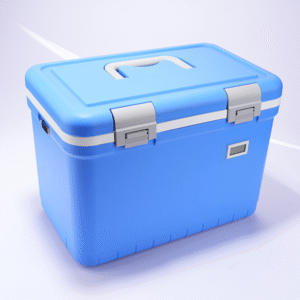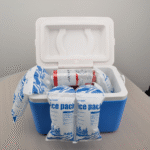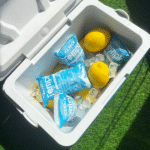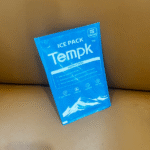The cold chain logistics market is booming, and regulators are tightening expectations. You need to know cold chain management requirements to keep sensitive goods safe in transit. Por 2025 the pharmaceutical cold chain alone is projected to exceed US$65 billion and more than double by 2034. Global cold chain logistics—covering food, biologics and chemicals—is forecasted to grow from about US$293 billion in 2023 to over US$862 billion by 2032. Meeting requirements means maintaining precise temperatures, using validated packaging, monitoring conditions in real time and complying with evolving regulations. This guide explains what you must do and why it matters.

Core compliance elements – the specific requirements you must meet to preserve product integrity.
Building an effective system – nine elements of cold chain management and how to integrate them.
Regulamento & embalagem - 2025 environmental and labeling rules that affect packaging.
Tecnologia & IA – how IoT, blockchain and predictive analytics improve compliance.
Desafios & soluções – practical strategies to overcome temperature excursions, visibility gaps and equipment failures.
What are the core cold chain management requirements?
Keep products within the right temperature range and document every step. Authorities like the FDA and EMA require strict temperature control (2 °C – 8 °C for refrigerated goods, −20 °C for frozen and below −70 °C for ultra low storage). Compliance includes 24/7 monitoramento, validated equipment, secure storage, embalagem especializada, detailed record keeping, contingency plans and trained personnel. Failing to meet any element can cause product degradation, fines or recalls.
Why temperature control matters for biologics and vaccines
Biologics and mRNA vaccines are highly sensitive to temperature swings. Research shows that many refrigerated vaccines lose up to 20 % of their effectiveness after just one hour above +8 °C. Aproximadamente 35 % of vaccines are compromised due to temperature mishandling, costing healthcare systems millions and endangering patients. To maintain potency, cold chain operators use ultra low freezers (below −80 °C) for cell and gene therapies and keep vaccines in the +2 °C a +8 °C range. Cryogenic freezers reaching −150 °C support gene therapy logistics. These precise ranges highlight why continuous monitoring and validated equipment are non negotiable.
Typical cold chain temperature ranges
| Faixa de temperatura | Produtos de exemplo | Por que isso importa |
| Ambiente (15–30ºC) | Dry foods, some pharmaceuticals | Ventilation avoids heat build up |
| Legal (10–15ºC) | Queijo, produtos frescos | Preserves flavour and texture |
| Refrigerado (0–10 ° C.) | Vacinas, laticínios | Prevents bacterial growth and maintains freshness |
| Congelado (−30 °C to 0 °C) | Carne, frutos do mar, sobremesas congeladas | Provides long term preservation; needs deep freezing |
| Ultra low (< −80 °C) | Biologics, Vacinas de mRNA | Requires cryogenic freezers and redundant power |
Dicas e conselhos práticos
Farm to table shipments: Pre condition gel packs and use insulated packaging to keep produce between +2 °C e +8 °C. Add IoT sensors to alert you if the temperature rises.
Pharmacies and clinics: Store vaccines between +2 °C e +8 °C, evite congelar, and install medical grade refrigerators with digital data loggers.
Art and flower deliveries: Maintain a cool, slightly humid environment; pack items with moisture absorbing materials and monitor humidity alongside temperature.
Exemplo do mundo real: Em um 2025 case study, a mid size pharmaceutical distributor equipped its shipping network with IoT sensors and predictive analytics. The upgrade allowed real time alerts and predictive maintenance, reducing waste by 30 % and meeting Food Safety Modernization Act documentation requirements.
How to build an effective cold chain management system?
Integrate nine core elements to create a robust system. A cold chain management system combines technology, armazenar, embalagem, monitoramento, transporte, desembaraço alfandegário, qualification, product management and delivery. Each element plays a specific role—technology provides thermal stability via reusable packaging and phase change materials, storage uses cold rooms and medical refrigerators, packaging protects goods during transit, monitoring supplies continuous data, transportation ensures temperature control, customs clearance avoids delays, qualification validates packaging, product management secures inventory and delivery optimises the last mile. Missing even one component creates vulnerability.
Monitoring and data: the heart of the system
Advanced sensors—IoT, RFID and Bluetooth data loggers—deliver real time visibility and alerts. Hardware accounts for 78.1 % of the global cold chain monitoring market, showing the reliance on physical devices. Platforms integrate these devices with analytics to identify trends and trigger corrective actions. Por exemplo, 24/7 monitoring with alerts and secure audit trails helps operators respond quickly to deviations and demonstrates compliance during inspections.
Mesa: elements of an effective cold chain system
| Elemento | Key components | Propósito | Sua lição |
| Tecnologia | Reusable thermal packaging, materiais de mudança de fase | Provides thermal stability and predictive performance | Invest in validated technology to improve reliability |
| Armazenar | Cold rooms, medical refrigerators, recipientes isolados | Maintains temperature during warehousing | Use correct equipment and monitor capacity |
| Embalagem | Insulated envelopes, recipientes, pallet systems | Protects goods during handling and transit | Match packaging to product and journey duration |
| Monitoramento | Registradores de dados, Indicadores de temperatura, Sensores Bluetooth | Delivers real time visibility and alerts | Deploy continuous monitoring to catch excursions early |
| Transporte | Refrigerated vehicles, frigoríficos, IoT telematics | Controls temperature during shipping and last mile | Plan routes and schedule maintenance |
| Customs clearance | Proper documentation and compliance | Avoids delays and spoilage | Prepare paperwork and coordinate with brokers |
| Qualificação | Thermal packaging qualification testing | Ensures packaging meets GDP standards | Perform routine validations and audits |
| Product management | Adequate storage, trained personnel, suprimentos | Secures products through the lifecycle | Train staff and maintain equipment inventory |
| Entrega | Risk management, experienced couriers | Reduces last mile excursions | Optimise last mile operations and contingency plans |
Practical tips for building your system
Conduct a gap analysis: map your operations against the nine elements and address weaknesses.
Choose packaging carefully: select thermal packaging appropriate for the product’s temperature range and consider reusable options to reduce waste.
Verify temperature qualification: perform qualification studies before shipping to ensure packaging works under extreme conditions.
Planeje a logística da última milha: coordinate with carriers, schedule deliveries during cooler times and provide recipients with narrow delivery windows to avoid excursions.
Educate your staff: train team members in proper handling, procedimentos de monitoramento e emergência; update them as new products or regulations arrive.
What are the packaging and regulatory requirements in 2025?
Sustentabilidade, traceability and product specific rules shape packaging. Regulatory bodies worldwide are aligning around waste reduction, sustainability and transparency. Businesses must use packaging materials that are recyclable, compostable or reusable. Efficient packaging—lightweight and space saving—reduces environmental impact and operational costs. Clear and informative labels are required for recyclability instructions and material identification. Product specific regulations now demand tamper evident seals and moisture barriers for pharmaceuticals and electronics. Perishable goods packaging must maintain freshness and extend shelf life.
Responsabilidade Estendida do Produtor (Epr) laws shift waste management burdens from governments to producers. States like Delaware and Illinois have banned Styrofoam containers and certain plastic bottles. Key principles driving packaging regulations include mandatory sustainable materials, restrictions on single use plastics, traceable labels, and enforcement mechanisms for non compliance. Companies must audit their packaging supply chain, source compliant materials and prepare for reporting requirements.
Sustainable refrigerants and materials
Cold chain operators are transitioning to eco friendly refrigerants such as hydrofluoroolefins (HFOs) and CO₂ based systems, which have low global warming potential. Reusable insulated shippers and phase change materials reduce reliance on single use plastics. Some warehouses aim to reduce frozen storage temperatures from −18 °C to −15 °C to cut energy consumption. Using recycled or biodegradable packaging materials not only meets regulations but also improves brand reputation and operational sustainability.
Preparing for audits and documentation
Detailed record keeping is essential: maintain calibration certificates, temperature logs, registros de treinamento e relatórios de desvio. Desenvolva procedimentos operacionais padrão (POPS) that cover general information, routine storage and handling, and emergency transport. Train staff during orientation and annually thereafter, and appoint a vaccine coordinator responsible for ordering, inventory management and responding to temperature excursions. Audit packaging suppliers for compliance with sustainability and hygiene requirements.
How do technology and AI transform cold chain management?
Sensores de IoT, blockchain and predictive analytics offer real time visibility and proactive risk management. IoT devices monitor temperature, umidade e localização, sending data to cloud platforms that trigger alerts when deviations occur. Blockchain creates an immutable ledger that improves traceability and prevents data manipulation. Artificial intelligence analyses historical data to optimise routes, forecast demand and identify potential disruptions, reduzindo o risco de variações de temperatura. Solar powered cold rooms and portable cryogenic freezers extend refrigeration capabilities in remote areas.
Digitalisation and predictive maintenance
Fleet management software can optimise cold chain operations by providing real time monitoring, route optimisation, compliance tools and efficiency improvements. Em 2025 cold chain management solutions incorporate AI driven analytics to predict equipment failures and schedule maintenance before breakdowns occur. Por exemplo, data driven predictive maintenance prevents refrigeration unit failures that would otherwise compromise product integrity.
Estudo de caso
Em 2025 a European pharmacy chain implemented IoT sensors recording temperature every five minutes across its inventory. Real time alerts enabled staff to adjust cooling units quickly, improving compliance and reducing product waste. Another example: a dairy exporter used AI predictions to anticipate customs clearance delays and route shipments accordingly, reducing clearance time by 40 %.
What are common challenges and how can you mitigate them?
Conformidade regulatória, clima, visibility and equipment failures top the list. Regulatory compliance requires accurate documentation and detailed records at every stage. Weather conditions can cause sudden temperature fluctuations; operators must use enhanced insulation, backup power sources and reliable refrigeration to counteract external conditions. Lack of visibility increases the risk of unnoticed excursions; deploying continuous monitoring and instant communication solves this problem. Equipment failures can lead to immediate temperature loss and product compromise.
Strategies to overcome these challenges
Improve documentation: Use digital logs and integrated systems to ensure records are accurate and accessible.
Weather resilience: Choose packaging and vehicles that can withstand extreme temperatures, and plan routes that avoid severe conditions.
Visibilidade em tempo real: Deploy IoT sensors and telematics for continuous temperature monitoring and immediate alerts.
Preventive maintenance: Schedule regular maintenance and equip vehicles with backup refrigeration to minimise risk.
Risk mapping: Identify and address supply chain stress points; por exemplo, collaborate with customs brokers to reduce delays.
Best practices for cold chain logistics and shipping
Follow pre shipment, transit and post delivery protocols to preserve quality. Antes do envio, pre condition refrigerants to the correct temperature, assemble and store packages in a temperature controlled environment and train staff on SOPs. Durante o trânsito, include real time or passive temperature monitoring devices, avoid mid route handling and ensure documentation is secure and visible. Após a entrega, inspect packaging promptly, download and review temperature data and conduct quality checks to confirm product integrity.
Holistic approach to cold chain success
Strong performance results from collaboration across suppliers, carriers and quality teams. A systems based approach reduces waste, avoids costly delays, maintains compliance and increases customer satisfaction. Pair packaging innovations with route optimisation and staff training to deliver reliable results.
2025 latest developments and trends
Visão geral de 2025 tendências
Analysts report that the global cold chain logistics market will grow rapidly, reaching over US$862 billion by 2032 and potentially surpassing US$1.3 trillion by 2034. Trends shaping the industry include geopolitical resilience, enhanced visibility software, novas categorias de produtos (plant based proteins) and modernisation of cold storage facilities. Operators are adopting IoT and sensor technology, blockchain, AI and predictive analytics to improve temperature control and logistics planning. Sustainable initiatives such as solar powered cold rooms, portable cryogenic freezers and eco friendly packaging are gaining traction.
Latest progress and their practical implications
Geopolitical resilience and capacity planning: Flexible routes and diversified networks help companies navigate disruptions.
Enhanced visibility software: Real time platforms improve tracking and inventory planning, enabling immediate intervention.
New dietary products: The rise of plant based proteins introduces new temperature requirements and logistic complexities.
Modernised facilities: Upgrades to cold storage warehouses improve energy efficiency and automation while replacing harmful refrigerants.
IoT e sensores: Continuous monitoring reduces waste by allowing early corrective actions.
Blockchain: Improves traceability and reduces data manipulation, ensuring authentic supply chains.
IA & análise preditiva: Optimises routes and predicts equipment failures.
Solar and cryogenic innovations: Solar powered cold rooms and portable cryogenic freezers extend cold chain reach.
Sustainable packaging and temperature adjustments: Shifting frozen storage from −18 °C to −15 °C to reduce energy use and employing biodegradable insulation.
Market insights and segmentation
The global cold chain monitoring market is projected to grow from US$35.03 billion in 2024 to US$119.74 billion by 2030 com um 23 % Cagr. North America holds more than 33 % of revenue while Asia–Pacific posts the fastest growth. Hardware—including sensors and RFID devices—makes up 78.1 % of market revenue. Food and beverage applications account for sobre 77 % of usage, while pharmaceuticals are the fastest growing segment. Data from Lascar Electronics shows the pharmaceutical cold chain sector will exceed US$65 billion in 2025 e alcance over US$130 billion by 2034.
Perguntas frequentes
Q1: What temperature range must I maintain for different products?
Most refrigerated pharmaceuticals require +2 °C – +8 °C. Standard frozen goods need −20 °C, while ultra low biologics may demand temperatures below −70 °C. Always consult product specific guidance and calibrate your equipment accordingly.
Q2: How often should I calibrate monitoring devices?
Regulatory guidelines recommend calibrating thermometers and refrigeration units at least twice a year and documenting the results. Regular calibration ensures accuracy and compliance.
Q3: What is Extended Producer Responsibility (Epr) and how does it affect packaging?
EPR laws require producers to account for the entire lifecycle of their packaging, including disposal. Businesses must use recyclable or compostable materials and may face penalties for non compliance.
Q4: What technologies deliver real time visibility in cold chain logistics?
Sensores de IoT, RFID tags and Bluetooth data loggers provide continuous temperature and location data. Blockchain ensures data integrity and AI analyses trends to prevent excursions.
Resumo e recomendações
Meeting cold chain management requirements in 2025 involves more than just refrigeration. You must maintain precise temperature ranges, use validated storage and packaging, monitor conditions continuously and document every action. Integrating nine core elements—technology, armazenar, embalagem, monitoramento, transporte, desembaraço alfandegário, qualification, product management and delivery—creates a resilient system. Regulatory and packaging rules emphasise sustainability and transparency. Tecnologias como IoT, blockchain and AI enable real time visibility and predictive maintenance. Common challenges such as weather, visibility gaps and equipment failures can be mitigated with robust processes and preventive strategies. By following best practices and staying abreast of trends, you can preserve product quality, ensure compliance and build consumer trust.
ACTO ACEDIVO PRÓXIMO PASSOS
Perform a compliance audit: Evaluate your current procedures against regulatory requirements and the nine element framework. Identify gaps in temperature control, documentation or training.
Upgrade monitoring technology: Invista em sensores IoT, RFID tags and cloud based analytics to achieve real time visibility and automated alerts.
Revise packaging strategy: Source sustainable, compliant materials and validate them for your products’ temperature ranges. Replace single use plastics with reusable shippers and phase change materials.
Treine sua equipe: Schedule regular training on handling, monitoring and emergency protocols. Assign a coordinator to oversee cold chain procedures.
Planeje contingências: Develop written SOPs for power outages, equipment failures and transport delays. Equip facilities with backup generators and extra refrigerants.
Sobre Tempk
We are specialists in temperature controlled logistics and packaging. Our research and development centre focuses on reusable and recyclable cold chain products, while our eco friendly solutions use low GWP refrigerants and durable insulation. We design packaging and monitoring systems tailored to pharmaceuticals, food and other sensitive goods. Our team combines decades of experience with modern AI enabled tools to help clients maintain compliance and reduce waste.
Chamado à ação
Ready to strengthen your cold chain? Contact our experts to audit your operations, select compliant packaging and implement real time monitoring. We’ll help you meet evolving 2025 regulations and protect your products.























